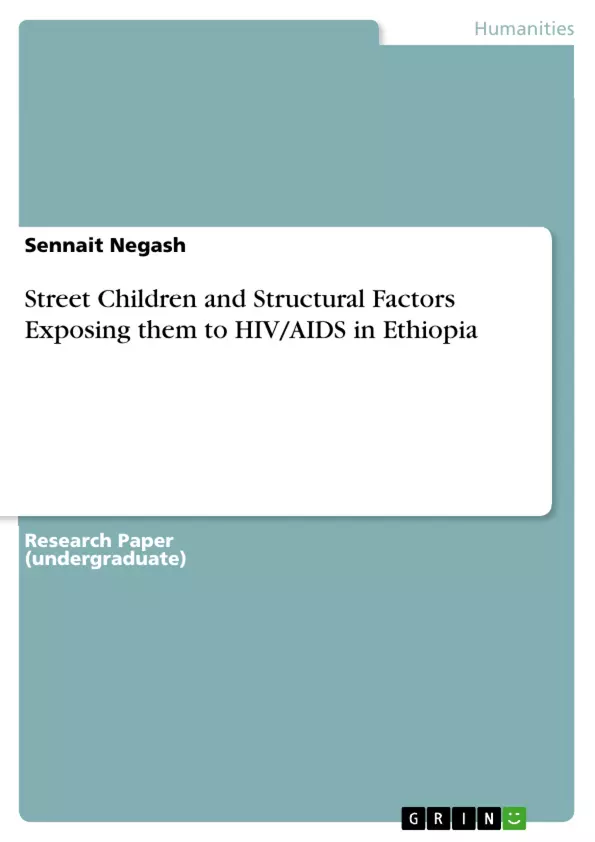HIV/AIDS has become the threat of this century, especially for the low income developing countries like Ethiopia. The study presents a multi-level framework for analysis of the links between homelessness and HIV. It assesses the relation of homelessness with structural macro factors like lower socio-economic status, limited power in the society and individual level factors stressors unique to the homelessness context including depleted psychosocial resources and low use of health services.
Inhaltsverzeichnis (Table of Contents)
- Introduction
- Structural Factors to HIV/AIDS Intervention and Behavioural Change Approach
- Definition of Street Children
- General Conditions of Ethiopian Street Children
- Gender, Age and Living Area of Street Children
- Factors Pushing Children to Street life
- Survival Coping Methods of Street Children
- HIV/AIDS and Street Children in Ethiopia
- Conclusions
Zielsetzung und Themenschwerpunkte (Objectives and Key Themes)
This paper examines the complex relationship between street children and HIV/AIDS in Ethiopia. It explores the structural factors that expose street children to the virus and analyzes the factors contributing to the vulnerability of this population. The paper presents a multi-level framework for understanding the links between homelessness and HIV, taking into account both macro-level societal factors and individual-level stressors unique to the homeless context.
- The prevalence of HIV/AIDS in Ethiopia and its impact on the population.
- The socioeconomic and structural factors contributing to the vulnerability of street children to HIV/AIDS.
- The specific challenges faced by street children in accessing healthcare and preventive measures.
- The impact of poverty, family breakdown, and societal marginalization on children's vulnerability to HIV/AIDS.
- The need for comprehensive interventions that address both structural and individual-level factors to mitigate the risk of HIV infection among street children.
Zusammenfassung der Kapitel (Chapter Summaries)
- Introduction: Provides a brief overview of Ethiopia's socio-economic context, highlighting key statistics on poverty, population growth, and the prevalence of HIV/AIDS. The chapter also introduces the problem of street children in Ethiopia, emphasizing the alarming number and their vulnerability to various health risks, including HIV/AIDS.
- Structural Factors to HIV/AIDS Intervention and Behavioural Change Approach: This chapter delves into the concept of structural factors that influence HIV/AIDS prevention and behavioral change. It examines the interconnectedness of societal structures, policies, and individual behavior in shaping the spread of the virus.
- Definition of Street Children: This chapter provides a comprehensive definition of street children, outlining the characteristics, living conditions, and social realities of children who live and work on the streets. It explores the various factors that contribute to child homelessness and the specific challenges they face.
- General Conditions of Ethiopian Street Children: This chapter analyzes the specific circumstances of street children in Ethiopia. It examines the demographics of the population, including gender, age, and geographic distribution. The chapter also explores the living conditions, survival strategies, and vulnerabilities experienced by street children in the Ethiopian context.
- Factors Pushing Children to Street life: This chapter delves into the underlying causes of child homelessness in Ethiopia. It examines various contributing factors, including poverty, family breakdown, conflict, and societal marginalization. The chapter explores the complex interplay of these factors and their impact on the lives of children who end up living on the streets.
- Survival Coping Methods of Street Children: This chapter focuses on the strategies that street children employ to survive on the streets. It explores the various ways they earn a living, including begging, petty crime, and involvement in the informal economy. The chapter also examines the risks and vulnerabilities associated with these coping methods.
- HIV/AIDS and Street Children in Ethiopia: This chapter explores the specific challenges and risks associated with HIV/AIDS among street children in Ethiopia. It examines the factors that expose them to the virus, such as unsafe sex, lack of access to healthcare, and the prevalence of sexually transmitted infections (STIs) among this population.
Schlüsselwörter (Keywords)
Street children, HIV/AIDS, Ethiopia, structural factors, vulnerability, homelessness, poverty, family breakdown, societal marginalization, healthcare access, prevention, behavioral change, coping mechanisms, survival strategies, sexual exploitation, child labor.
- Quote paper
- Sennait Negash (Author), 2010, Street Children and Structural Factors Exposing them to HIV/AIDS in Ethiopia, Munich, GRIN Verlag, https://www.hausarbeiten.de/document/160900


